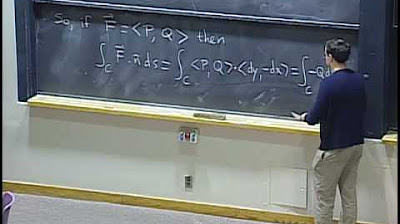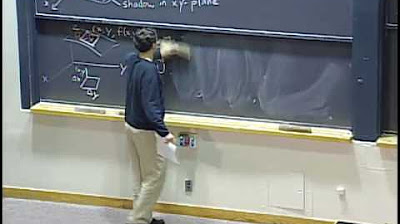How to Calculate Flux (Line Integrals)
TLDRThis video script from Houston Math Prep dives into the concept of line integrals, specifically focusing on flux. It explains how to calculate the flow of a vector field across a curve using the normal component of the field and the arc length element. The script provides step-by-step examples, including calculating the flux of a vector field across a circle of radius 3 centered at the origin, for three different vector fields. The examples illustrate how flux can be positive, zero, or negative, depending on the orientation of the field relative to the curve, offering a clear understanding of the concept.
Takeaways
- 📚 The video discusses the concept of line integrals, particularly focusing on flux, which is the measure of flow through a curve in a vector field.
- 📐 The normal vector \( \vec{n} \) to the curve is defined as \( (-y', x') \) when traveling along the curve in a counterclockwise direction, pointing to the right.
- 🔍 Flux is calculated using the line integral of the dot product of the vector field \( \vec{f} \) and the unit normal vector \( \hat{n} \) to the curve.
- 📈 The formula for flux involves integrating \( \vec{f} \cdot \hat{n} \) with respect to the arc length \( ds \), which can be expressed as \( \int (m \, dy - n \, dx) \).
- 🌐 The magnitude of \( \hat{n} \) is the same as the magnitude of the derivative of the position vector \( \vec{r}' \), simplifying the expression for flux.
- 📝 An example is provided to calculate the flux of the vector field \( (x, y) \) across a circle of radius 3 centered at the origin, resulting in a flux of \( 18\pi \).
- 🔄 Another example with a different vector field \( (-y, x) \) across the same circle results in zero flux, indicating no net flow across the curve.
- 🌀 A third example with the vector field \( (-x, -y) \) across the circle results in a negative flux of \( -18\pi \), showing inward flow towards the origin.
- 📚 The video script also mentions upcoming topics such as gradient fields, conservative fields, and path independence in the context of line integrals.
- 👋 The presenter thanks the viewers and indicates that more information on shortcuts for line integrals will be provided in future videos.
Q & A
What is a line integral involving flux?
-A line integral involving flux measures the flow of a vector field through a curve. It calculates the amount of the field passing through the curve in a given direction.
How is the normal vector to a curve defined in the context of flux?
-The normal vector to a curve, denoted as n, is defined as (y', -x'). This vector is perpendicular to the tangent of the curve and points to the right as one travels along the curve.
What is the formula for the flux through a curve?
-The flux through a curve is given by the line integral of the vector field F dotted with the unit normal vector n-hat over the curve, expressed as ∫ F · n-hat ds.
How do you parameterize a circle of radius 3 centered at the origin?
-A circle of radius 3 centered at the origin can be parameterized as r(t) = (3 cos(t), 3 sin(t)), with t ranging from 0 to 2π.
How do you compute the differential forms dy and dx in terms of t for the parameterized circle?
-For the parameterized circle r(t) = (3 cos(t), 3 sin(t)), the differentials are dx = -3 sin(t) dt and dy = 3 cos(t) dt.
What is the result of the flux calculation for the vector field F(x, y) = (x, y) across the circle of radius 3?
-The flux of the field F(x, y) = (x, y) across the circle of radius 3 centered at the origin is 18π.
How is the flux affected if the vector field is F(x, y) = (-y, x)?
-For the vector field F(x, y) = (-y, x), the flux across the circle of radius 3 is zero because the field is rotational and there is no net outward or inward flow.
What does it mean when the flux is zero for a rotational vector field?
-A zero flux for a rotational vector field indicates that there is no net flow through the curve; the flow is tangential and does not cross the curve outward or inward.
What is the flux result for the vector field F(x, y) = (-x, -y) across the same circle?
-The flux of the field F(x, y) = (-x, -y) across the circle of radius 3 centered at the origin is -18π, indicating inward flow.
How does inward flow affect the sign of the flux?
-Inward flow results in a negative flux value, as the flow is directed toward the center of the curve rather than outward.
What is the significance of the unit normal vector n-hat in flux calculations?
-The unit normal vector n-hat is crucial in flux calculations as it determines the direction in which the flux is measured. It ensures that the flow is measured perpendicularly to the curve.
Why is the magnitude of the normal vector equal to the magnitude of the derivative of the parameterized curve?
-The magnitude of the normal vector is equal to the magnitude of the derivative of the parameterized curve because both vectors have the same length, ensuring n-hat is a unit vector.
How does the parameterization of a curve help in computing line integrals?
-Parameterization of a curve helps in computing line integrals by providing a way to express the coordinates and differentials (dx, dy) in terms of a single parameter t, simplifying the integration process.
Outlines
📚 Introduction to Line Integrals and Flux
This paragraph introduces the concept of line integrals, specifically focusing on flux. The speaker explains how to represent a path in space using a vector function, defines the normal vector 'n' to the curve, and discusses its orientation. Flux is described as the measure of flow through a curve, and the formula for calculating it is given, involving the dot product of the field vector 'f' and the unit normal vector 'n hat'. The importance of the unit vector and the arc length element 'ds' is highlighted, leading to an expression for flux in terms of the integral over the curve of 'f dot n dt'. The paragraph concludes with a transition to calculating the flux of a field across a circle.
🔍 Calculating Flux Across a Circle with a Specific Vector Field
The speaker provides a detailed example of calculating the flux of a vector field across a circle of radius 3, centered at the origin, with the circle oriented counterclockwise. The parameterization of the circle is given, and the vector field is described. The process involves substituting the parameterized values of x and y into the field components 'm' and 'n', and then finding the differentials 'dx' and 'dy'. The flux calculation is shown step by step, leading to the integral of '9 cos^2(t) - 9 sin^2(t)' over the interval from 0 to 2π. The Pythagorean identity is applied to simplify the integral, resulting in a flux of '18π'. The explanation includes a visual representation of the flow across the curve.
🔄 Exploring Different Vector Fields and Their Flux
This paragraph continues the exploration of flux with different vector fields across the same circular path. The first example uses a vector field of '-y, x', resulting in a flux calculation that integrates to zero, indicating no net flow across the curve due to the rotational nature of the field. The second example uses a field of '-x, -y', leading to a negative flux of '-18π'. This result is interpreted as an inward flow towards the origin, contrasting with the first example's outward flow. The paragraph concludes with a visual explanation of the flow directions relative to the curve and the observer's orientation, emphasizing the concept of positive and negative flux.
🚀 Conclusion and Preview of Upcoming Topics
In the concluding paragraph, the speaker summarizes the discussion on flux and hints at future topics. These include shortcuts for line integrals, gradient fields, conservative fields, and the concept of path independence. The speaker thanks the viewers for watching and indicates that more information will be provided in the next video, encouraging continued learning and engagement with the subject matter.
Mindmap
Keywords
💡Line Integrals
💡Flux
💡Vector Field
💡Normal Vector
💡Parameterization
💡Differential Form
💡Arc Length
💡Tangent Direction
💡Pythagorean Identity
💡Counterclockwise Orientation
Highlights
Introduction to line integrals involving flux, a concept that measures the flow through a curve in space.
Explanation of the normal vector 'n' to a curve, defined as y' and -x', pointing to the right as one travels along the curve.
Flux is defined as the line integral of the flow through a curve, using the formula involving the dot product of the field and the normal unit vector.
Clarification that n̂ is a unit vector pointing in the normal direction and is derived from dividing the normal vector by its magnitude.
The differential form of flux is presented as the integral over the curve of mdy - ndx, where m and n are components of the vector field.
Calculation of flux for a field across a circle of radius 3 centered at the origin, using the parameterization of the circle and the field components.
Integration of the flux formula resulting in a positive value, indicating an outward flow through the curve.
Demonstration of how the vector field and curve orientation affect the direction and magnitude of flux.
Second example with a different vector field over the same circle, resulting in zero flux due to the rotational nature of the field.
Illustration of the concept that no outward or inward flow occurs when the field is purely rotational with respect to the curve.
Third example with yet another vector field, showing how changes in the field can lead to negative flux, indicating inward flow.
Explanation of the Pythagorean identity's role in simplifying the flux calculation, leading to the integral of a constant.
Final example's flux calculation resulting in negative 18 pi, showing the impact of field direction on the sign of flux.
Discussion on the implications of flux direction, indicating inward flow towards the origin for a radial field.
Teaser for upcoming topics on shortcuts for line integrals, gradient fields, conservative fields, and path independence.
Transcripts
Browse More Related Video

Line Integrals of Vector Fields (Introduction)

Lec 23: Flux; normal form of Green's theorem | MIT 18.02 Multivariable Calculus, Fall 2007

How to Calculate Circulation (Line Integrals)

Calculus 3: Surface Integrals and Flux (Video #33) | Math with Professor V

Conservative Vector Fields & Potential Functions

Lec 28: Divergence theorem | MIT 18.02 Multivariable Calculus, Fall 2007
5.0 / 5 (0 votes)
Thanks for rating: